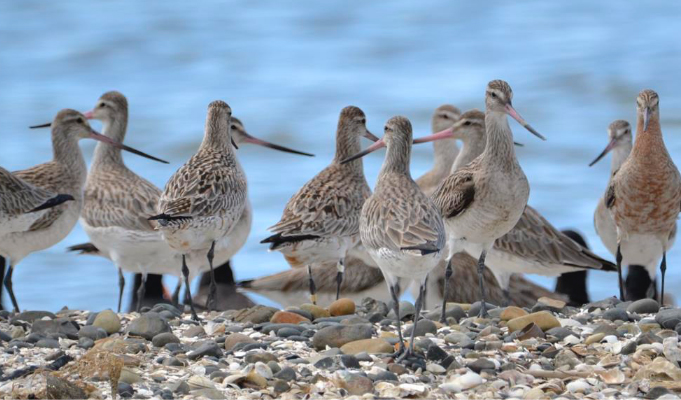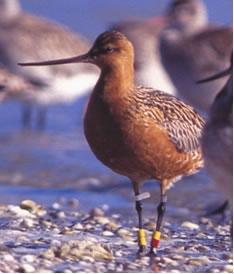Arctic Wader Colour-Banding Scheme

Background
Birds New Zealand is studying the movements of Arctic-breeding waders in New Zealand, by individually colour-marking Bar-tailed Godwits, Red Knots and Ruddy Turnstones in both the North and South Island. The aim is to determine whether individual birds use a network of sites while in New Zealand, and if so, on what scale. Knowing whether sites or regions have discrete populations is important for interpreting local population changes, as well as informing management decisions. There is also interest from biosecurity agencies to determine the avenues of disease spread amongst birds in New Zealand, and northern hemisphere migrants are perceived as being potential sources of diseases entering the country.
Birds are banded with individual colour-combinations that can be seen from a distance, enabling Birds New Zealand members and other birdwatchers to contribute to the project by getting out and looking at birds legs.
What do the combinations look like? 
Birds will have two colour-bands on each tarsus (lower leg). The bands are white, yellow, red or blue. There will also be a single white or red leg-flag, which is made of the same material as the bands but projects out from the leg. The position of the flag is important! It can be on either the upper leg (tibia), or down with the colour-bands on the lower leg. If the flag is on the lower leg, you will need to note if it is above the bands, between them or below them.
On this Bar-tailed Godwit the four colour-bands and single leg-flag are clearly visible. The numbered metal band that is on the bird’s upper left leg does not form part of the combination. (Image taken by Brian Chudleigh)
How do we record the combinations?
The colour-bands are read from the upper band on the left leg to the lower band on the right leg. The godwit is therefore YRYY (yellow above red on the left leg, yellow above yellow on the right leg), with the white flag on the right tibia. In the field, it can be useful to draw a picture of the bands:
| Left Leg | Right Leg | |
| – | W-flag | |
| Upper Leg | Y | Y |
| Lower Leg | R | Y |
What else do we look for?
If the bird is a godwit, it can be possible to tell its sex. Females are quite a bit larger than males, with proportionately longer bills. Males go into much darker breeding plumage than females. If you think know the sex of the bird, put it down – this can help figure out who is who if the combination was not read fully.
At some times of the year birds will be moulting into or out of breeding plumage. While giving a value to a breeding plumage score is somewhat subjective, the following scale is fairly robust:
1 = full non-breeding plumage
2 = mostly non-breeding with a trace of breeding plumage
3 = ¼ breeding plumage
4 = ½ breeding plumage
5 = ¾ breeding plumage
6 = mostly breeding plumage with just a trace of non-breeding remaining
7 = full breeding plumage
Most birds will probably not do all their moult in New Zealand, but will leave on northward migration with some non-breeding plumage remaining.
When is the best time to look for bands?
The best time to look is not at high tide. Then birds are usually packed together, standing on one leg or sitting down, or hiding amongst vegetation. It is much better to scan for bands when birds are feeding, or moving around near a roost as the tide comes in. If you are going to look for bands, it pays to turn up an hour or two earlier than you usually would at a high-tide roost, or be prepared to stay until the birds move out onto the tidal flats to start feeding.
Is it still useful to report a partially-read combination?
Absolutely! This is especially true at sites away from the banding areas, where it can be important to know birds visited, even if we cannot figure out who it was.
How do we report sightings?
The best way (if you have a computer) is to fill in the band reporting Excel spreadsheet and email it to us. Otherwise snail-mail will work. The spreadsheet may look like a lot of work, but some of it needs to be done only once. An example of a filled-in sheet is provided here. The information we would like is:
- Species – Use the drop-down menu, and fill in one form per species.
- Your name – Enter this each time you fill in a sheet.
- Your address / email / phone – Fill these in the first time you submit a record; you will not need to thereafter.
- Site name – e.g. Tapora, Kaipara Harbour.
- Habitat – A general description, e.g. shellbank roost, tidal mudflat, Sarcocornia saltmarsh.
- NZ grid reference / lat-long – If you have one of these to hand, enter it (again, once only).
- Date of observation
- Weather/light – e.g. Windy, poor light; Calm, sunny, bright.
- Time – Start and end of observation period.
- High tide time – If you know it.
- Stage of tide – Use drop-down menu: low / incoming / high / outgoing.
- Activity of birds – Use drop-down menu: feed / preroost / roost.
- Number of birds present – Total count, and use the pull-down menu to say if this is a count or estimate.
- Number of birds checked – How many did you get to check the legs of? Also use the pull-down menu to say if this is a count or estimate.
- Number of banded birds seen – Include all banded birds, even if you got only part of the combination.
To enter the combinations:
Put the bands in the left column (e.g. YRYY). If you are not certain of a band colour, put it in brackets with a question mark, e.g. Y(R?)YY. If you could not see a band at all, put a question mark in the combination, e.g. Y?YY, ??RB.
The eight possible flag positions are given in the next columns. Put a ‘1’ in the correct column. You can then enter the sex and breeding plumage score if you have them, and make a comment about the bird.
Any general comments can be typed in below the bands when you are done.
There is a blank worksheet where you can enter and pre-sort records to figure out how many birds there were.
Saving the file – A file name that is self-explanatory is best, e.g. “knot Phil Battley June 21 2004.xls”.
Sending the records in:
North Island
Phil Battley
Ecology Group, Massey University
Private Bag 11-222
Palmerston North 4442
p.battley@massey.ac.nz
06 356 9099 ext. 2605
South Island
Rob Schuckard
Taipari Bay
RD3 Rai Valley
Marlborough Sounds
rschckrd@xtra.co.nz
03 576 5371
For more information about the project, or if you wish to become more fully involved, please contact either Phil or Rob at the addresses above.
Wader reporting Form (XLS)
Sample Form (PDF)